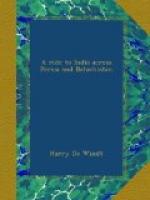Jebri Fort stands on a steep hillock about fifty feet in height. From here a good view was obtainable of the surrounding country. Immediately below were pretty gardens or enclosed spaces, sown in the centre with maize, wheat, and tobacco, and surrounded by plum and pomegranate trees and date palms. There is a considerable trade in the latter between here and Beila, which perhaps accounted for the myriads of flies which here, as at Gajjar, proved a source of great annoyance. In Chabas’s garden were roses and other flowers, some remarkably fine vines, and a number of mulberry trees. The grounds were well and neatly laid out with paths, grass plots, and artificial streams, upon which I complimented the old man; but he would talk of nothing but his fort, which was, indeed, the only structure worthy of the name met with between Quetta and the sea. In the evening his son brought me a delicious dish of preserved apricots and cream, for which I presented him with three rupees, one of which he instantly returned. It is considered, by Baluchis, extremely unlucky to give or accept an odd number of coins.
[Illustration: JEBRI]
At Jebri, for the first time, we suffered severely from cold at night, the thermometer dropping to 42 deg. Fahr. just before sunrise. The climate of Baluchistan presents extraordinary varieties, and is extremely trying to Europeans. Although at Kelat the natives suffer considerably more from cold in winter than summer heats, the hot season in the low-lying valleys and on the coast, which lasts from April till October, may be almost said to be the most severe in the world. At Kej, in Mekram, the thermometer sometimes registers 125 deg. Fahr. in the shade as early as April, while the heat in the same district during the “Khurma-Paz,” or “Date-ripening,” is so intense that the natives themselves dare not venture abroad in the daytime.
Notwithstanding this, even the south of Baluchistan has its cold season. Near Beila, in the month of January, the temperature frequently falls as low as 35 deg. Fahr. in the mornings, rising no higher than 65 deg. at any portion of the day. At Kelat, on the other hand, which stands 6800 feet above sea-level, the extreme maximum heat as yet recorded during the months of July and August is only 103 deg. Fahr., while the extreme minimum during the same months is as low as 48 deg. Fahr. In winter the cold is intense. Pottinger, the traveller, relates that on the 7th of February, 1810, when at Baghivana, five marches from Kelat, his water-skins were frozen into masses of ice, and seven days afterwards, at Kelat, he found the frost so intense that water froze instantly when thrown upon the ground. Bellew, a more recent traveller, in the month of January found the temperature even lower, as when at Rodinjo, thirteen miles south of Kelat, the thermometer at 7 a.m. stood at 14 deg. Fahr., while the next night, at Kelat, it fell to 8 deg. Fahr. The weather was




